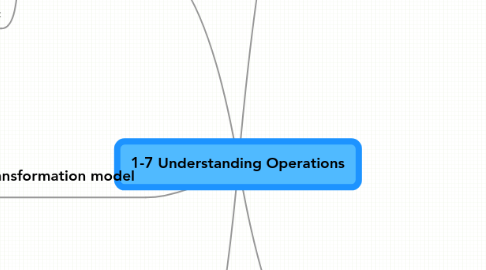
1. The operations manager role
1.1. Responsibilities
1.1.1. HR
1.1.2. Asset Management
1.1.3. Cost management
1.2. Decisions
1.2.1. Untitled
1.3. Interface to other functions
2. The transformation model
2.1. Macro and Micro Operations
2.1.1. Untitled
2.1.2. Internal customers
2.1.3. External customers
2.1.4. Interfaces
2.2. Boundaries of operations systems
2.2.1. Untitled
2.2.2. Suppliers
2.2.3. Customers
2.2.4. The environment
2.2.5. Closed vs. open systems
3. Objectives
3.1. Identify the operations management aspects of your own work
3.2. Apply the tranformation model to identify the inputs, transformation processes and outputs of an organisation
3.3. Identify the operational and administrative processes in your own organisation
3.4. Identify the roles and reponsibilities of operations managers in different organisational contexts
3.5. Define 'operations' and 'operations management'
3.6. Describe the boundaries of an operations system, and recognise its interfaces with other functional areas within the organisation and with its external environment
4. HIstorical development
4.1. Craft manufacturing
4.1.1. Low volume
4.1.2. High variety
4.1.3. Small scale, low competition
4.2. Mass production
4.2.1. High volume
4.2.2. Low variety
4.2.3. Low cost, high volume, aggressive advertising
4.2.4. Types
4.2.4.1. American system of manufacture
4.2.4.2. Scientific management
4.2.4.2.1. Taylor
4.2.4.2.2. One best way
4.2.4.2.3. narowly defined reptetitive tasks performed at high speed and low cost
4.2.4.3. Moving Assembly Lines
4.2.4.3.1. Ford
4.2.4.3.2. large volumes of standardised products assembled by unskilled workers
4.3. The modern period
4.3.1. Market changes
4.3.1.1. Fragmented markets
4.3.1.2. short product life cycles
4.3.1.3. Choice
4.3.2. Challenges from Japan
4.3.2.1. TQM
4.3.2.2. JIT
4.3.2.3. Employee involvement
4.3.3. Approaches
4.3.3.1. Flexible specialisation
4.3.3.2. Lean production (Toyota - reducing waste)
4.3.3.3. Mass customisation (high volume with adaptation)
4.3.3.4. Agile manufacturing (adapt fast to market)
5. Process perspective on organisations
5.1. Linked chains of activities cutting across departments and functional groups
5.2. View on the real work of the organisation
5.3. Operational processes
5.4. Administrative processes
5.5. Improvement
5.5.1. TQM
5.5.1.1. incremental improvement
5.5.1.2. continuous and small scale
5.5.1.3. Assumption: current process has something good
5.5.1.4. Statistical process control
5.5.2. BPR
5.5.2.1. Radical redesign
5.5.2.2. Assumption: current process is no good
5.5.2.3. No measurement
5.5.3. Common techniques
5.5.3.1. Process mapping
5.5.3.2. eliminate multiple approvals and checkpoints
5.5.3.3. reduce waiting time
5.5.3.4. improve interfaces between departments
5.5.3.5. group related tasks and responsibilities
5.5.3.6. Process owners
5.5.3.6.1. overcome functional boundaries
